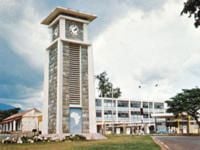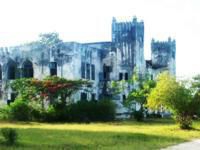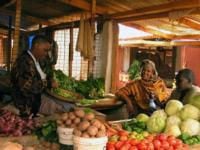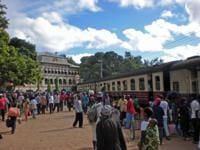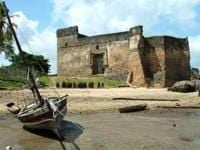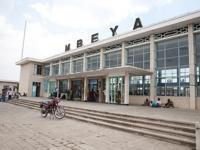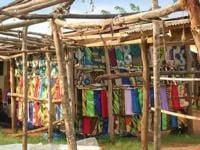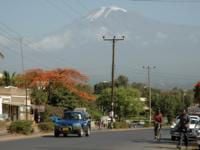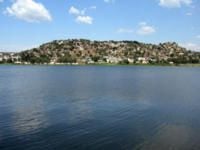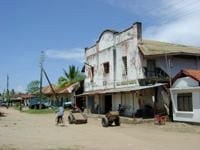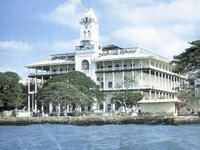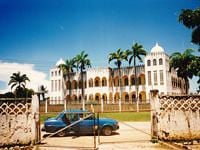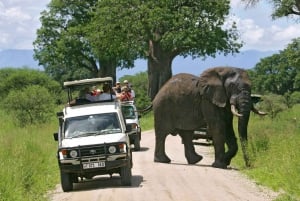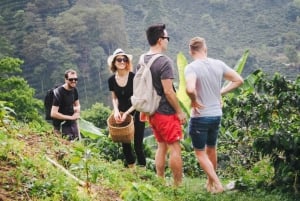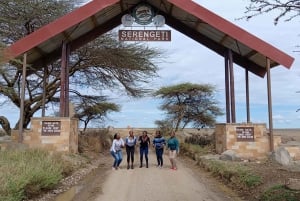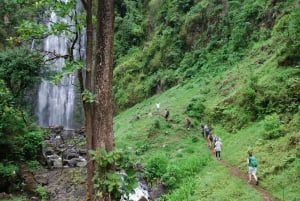Towns & Cities
Most of Tanzania's coastal towns were founded on ports from which slaves and valuable goods were transported across the Indian Oceans. Many inland towns on mainland Tanzania were important rest stops for trade caravans and in the northern highlands small towns founded by Germans were centres for colonial administration and agriculture. In modern day Tanzania most cities and towns still specialise in trade and agriculture and are the centres for economical and political activity in the regions. There are many historical and cultural sites of interest to visitors, especially in the coastal cities and towns.
Located in north Tanzania, beneath the peaks of Mount Meru and Mount Kilimanjaro, Arusha is the gateway to the northern safari circuit, and Tanzania’s third largest city. Built by the Germans as a centre for colonial administration in the early 20th century, Arusha was a sleepy town with a garrison stationed at the old boma and a few shops around a grassy roundabout. Today Arusha is one of the most prosperous towns in Tanzania. The town receives around 400,000 visitors a year as most use Arusha as a base from which to explore the nearby National Parks. Arusha is a cosmopolitan and diverse place, the town’s lively shops, markets, vibrant nightlife, cultural tourism and some exceptional restaurants provide plenty for visitors to stay longer.
Arusha is the site for the United Nations Criminal Tribunal on the Rwandan genocide and the head quarter for the Tripartite Commission for the East African Co-operation, making it a major centre for Tanzanian diplomacy and international relations.
Arusha’s altitude, at around 1,500m, ensures a temperate climate for most of the year. The cold season (April to August) requires warm clothes for the evenings as the nights can be very chilly. From November to February it is very hot.
Once the last stop for Arab slave traders Bagamoyo is now little more than large village, set on a beautiful mangrove fringed bay 72kms from Dar es Salaam. It was once one of the most important trading ports on the East African coast for the ivory and slave trade. Missionaries active in abolishing the slave trade made Bagamoyo a centre for their activities. There are many picturesque reminders and old buildings remains of the German colonial era which makes for an attractive day-trip.
Dar es Salaam is Tanzania’s largest city and its economic capital. From a settlement of 3,000 people little over a century ago; the city has grown in economic importance to become the prosperous centre in the East African region with almost 4,000,000 inhabitants. During the German occupation in the early 20th century, Dar as Salaam was the centre for colonial administration and the main contact point between the agricultural mainland and the world of trade and commerce in the Indian Ocean and Swahili coast.
Its bustling harbor is the main port in Tanzania and its industrial area produces products for export and for use throughout the country. Government offices all have their main base in Dar es Salaam, and diplomatic missions and non-governmental organizations in the country all have a presence in this cosmopolitan city.
For most travellers, Dar es Salaam is normally a stop over from where Zanzibar or southern Tanzania can be reached. It does boast of a few cultural museums, colourful markets, a lively music and arts scene and some excellent restaurants. Numerous historical landmarks include St Josephs Cathedral, The White Father’s Mission House, the Botanical Gardens and the old State House.
Located in the middle of Tanzania, Dodoma is the nation’s sanctioned political city. Although much smaller and less advanced than the country’s commercial centre, Dar es Salaam, Dodoma remains a hub for the country's politics. Situated on the eastern edge of the southern highlands, the city of Dodoma is surrounded by a rich farming area and pleasant scenery. In recent times this out of the way town is becoming the centre for Tanzania's growing wine industry. Dodoma has little interest to tourists, but nonetheless it is a pleasant place for a stop over. North of Dodoma visitors can explore Irangi Hills, where some of Africa's oldest prehistoric rock paintings can be found.
In recent times, the towns’ economic base has declined in favour of the coastal city, but in the early days of Tanzanian independence, there was a popular political motion to move the entire government to the town in the southern highlands. These days, the government divides it's time between Dodoma and Dar es Salaam
Located in the southern highlands of Tanzania, near the country’s legislative capital of Dodoma and the agricultural centre of Morogoro, Iringa is a pleasant small town and a focus of regional agriculture and production. Iringa is an attractive base for exploring it's outlying areas of forested hills, boulder-strewn wildernesses, fertile farmlands, and dusty red lowlands where big game species can be seen. Dodoma's streets are quiet and peaceful, and the market offers a vibrant scene of traditional African culture. Iringa overlooks the Little Ruaha River and is a popular stopping point for visitors to Ruaha National Park.
Visitors on their way to the Serengeti and Ngorongoro Crater pass through the town of Karatu. After climbing the Manyara Escarpment, the vegetation becomes more lush and green, finally entering into the highlands around Karatu.
Vast and extensive fields cover the slopes of the volcano and the lands around Karatu town. Coffee was a main crop grown for export, and a few large farms that remained in private hands still cultivate the cash crop on the hills and small valleys outside of town.
The bustling town of Kigoma is the regional capital of western Tanzania and a central port in the area. Located on the eastern shores of Lake Tanganyika, Kigoma is surrounded by rugged mountains and forests that make it a pleasing and beautiful location. Over the last decades Kigoma has gained a strong economic foothold in the region and its port is of central importance to the activities of the area.
Historically, the town was the final stop of the Central Line railway, built in the 20th century to transport agricultural goods from the African hinterland to the East African Coast. The town makes a good overland base for visits and chimpanzee safaris to both Gombe Stream National Park and Mahale Mountains National Park.
Along the southern coast of Tanzania, the ancient ruins of Kilwa Kisiwani lies amongst an encroaching jungle of mangroves and the never ending cycle of the tide. Once the very epicentre of Swahili culture and civilisation, all that is left of Kilwa Kisiwani are the old building blocks of the town -- fire baked limestone, coral blocks, and a few shattered tiles. The ruins are scattered around the present day Kilwa Kisiwani, whose simple mud huts provide a stark contrast to the wealthy town that Kilwa once was.
Near the Zambian border deep in the southern highlands, the city of Mbeya is the major agricultural capital in the country’s south-west region. Large coffee and tea plantations, banana farms, and fields of cocoa are all grown around the region. Mbeya’s location also makes it an idea transit point for good travelling by road and rail between Tanzania and neighbouring Zambia and Malawi.
The town was originally founded in the 1930’s, when gold was discovered and a ‘gold rush’ ensued. But instead of running out and becoming a ghost town, Mbeya has continued to supply the country with a regular amount of gold. Its mountain views and pleasant weather make it a good stopover point for over land travellers heading south.
Morogoro lies in the agricultural heartland of Tanzania, and is a centre of farming in the southern highlands. In addition to its agricultural importance, Morogoro is also the centre for missionary work that goes on in the country, and the various missions and their schools and hospitals are a central feature of the town.
The town of Morogoro lies at the base of the Uluguru Mountains, part of the Eastern Arc chain. Its close location to the peaks makes Morogoro an important stop for hiking trips to the Ulugurus.
Nestled at the base of Mount Kilimanjaro, Moshi is the coffee producing centre of the country. All around the town, and on the slopes of Kilimanjaro, vast plantations of coffee blanket the area. Sugar plantations are also of central importance to the region’s economy, and can be seen outside of town.
Walks around Moshi town and a trip to the coffee auction that is held here are activities of interest to passing visitors, but the main reason visitors come to Moshi is to climb Mt. Kilimanjaro, the mountain whose thick clouds and snow-capped peak towers over the agricultural town.
The city of Mwanza is the major Tanzanian port on Lake Victoria and a major centre of economic importance in the region. Around the city of Mwanza, the land is primarily devoted to agricultural enterprise. Tea, cotton, and coffee plantations throughout the area produce large volumes of cash crops that pass though Mwanza on their way to market. The town’s industrial harbour and busy streets make it a prosperous, and busy, place to explore.
The Pangani River passes through the north side of the town, separating the old buildings and the present-day market from the farms and small houses on the south side.
Once a centre of Swahili trade with the African mainland, Pangani is now a sleepy backwater town. Visitors passing through the area would do well to explore what remains of the old town on foot. Even a short walk rewards visitors with a glimpse of quiet life in the old trading towns along the Swahili Coast.
Stone Town is the old city and cultural heart of Zanzibar, little changed in the last 200 years. It is a place of winding alleys, bustling bazaars, mosques and grand Arab houses whose original owners vied with each other over the extravagance of their dwellings.
Stone Town was recently and deservedly declared a World Heritage Site by UNESCO.
Most of the houses that can be seen today were built in the 19th century when Zanzibar was one of the most important trading centres in the Indian Ocean region.
The sleepy town of Tabora, in the hinterland of western Tanzania, remains a key transit point in the country. The regions around Tabora are famous throughout Tanzania for the honey they produce, and large jerry cans and bottles of the famous liquid can be bought in the village market.
Historically, Tabora was once a major trading point and stopover for caravans that connected Lake Tanganyika and Central Africa with the coastal town of Bagamoyo to the northeast.
The bustling port of Tanga is Tanzania’s secondary port after the urban centre of Dar es Salaam. Yet although the port is a centre of marine export, import, and trade, the town of Tanga still has a quiet, laid-back feel to it, as if not much has changed over the decades.
Tanga was once another stopping point, in competition with Pangani and Bagamoyo, for caravans on their way to the hinterland of Central Africa searching for ivory and slaves.



